Mae Sot, Thai Burma Friendship Bridge/Charging Your Devices While Traveling

|
• Agape Apartments Hotel • Bara Hotel Budapest • Classic Hotel Budapest • Gold Hotel Buda Budapest |
Feature Photograph

A Classic Mini in Mae Sot
Some weeks back I wrote a blog entry poking fun at "Thai Individualism" in the area of customizing cars. Blinky blink lights, lighted steering wheels, comical exhaust tips, and other
such 'improvements' which are more likely to invoke laughter than they are an increase in performance or utility. This week's feature photograph shows a different and far more serious side to Thailand's car culture.
How many wonderfully restored Minis and other collectables have you seen running around Thailand? I've seen a bunch! Minis are popular, but not as popular as the Volkswagen Beatle. I've seen hundreds of proud Thai owners behind the huge steering wheels of their nicely restored Beatles. There are thousands of such cars in Thailand from many different countries.
This image is significant for two reasons. It shows a really fine example of a restored Mini, and it also shows proper perspective. Perspective? Yes. My 16 year old son took this image at my urging. We were in Mae Sot and the rain was coming down hard and we both spied this eye-catching Mini at the same time. Since I was driving I handed him the camera and pushed him out of the car into the rain to make the capture.
Minutes later my now soaking wet son was sitting next to me as we reviewed the captures on the LCD. Something was missing and we both knew it. My son and I are gear heads, especially where it concerns fine muscle cars for me and tuner imports for him. We've seen and taken plenty of quality car captures. He glared at me in that special way that conveys that timeless "thanks a hell of a lot dad"
unspoken message and climbed back out into the rain to make a proper capture.

Same Mini, different perspective
As you can see above the first capture was taken with little thought and shows a perspective looking straight down on the Mini. We tend to use this perspective for almost every picture because we're mostly standing on our two feet for almost every picture. In a very strong way by using this perspective so often, it results in many of our pictures looking the same even if the subjects are different!
In order to capture the Mini with the most appropriate and desirable perspective my son had to do two things while standing out in the rain. He needed to set the lens to a wider angle and move closer to the car, and to squat down on his heels so the angle was looking up rather than down.
We need to remember this when making most any capture. Can we make the perspective more interesting by merely changing the angle and perhaps the focal length? We should think about these two things when taking any image. You can compare the two images and see for yourself.
Mae Sot, Thai Burma Friendship Bridge
Mae Sot
I'm adding Mae Sot to my 'most favorite' list of Thailand cities. Located in Tak province approximately 512km from Bangkok, Mae Sot sits at about 210 meters above sea level and is home to roughly 45,000 permanent residents. The higher elevation and dense forests help explain the much cooler temperatures and almost constant rain. At almost any time of the day or night, there is a 10 C difference between Mae Sot and Bangkok. This is one of the few places in Thailand where I can be truly comfortable with the weather during the most hot months of the year.
The Drive
Leaving Bangkok on the Expressway you head out towards the old Don Meuang international airport until the Expressway ends. Soon you're on Highway 32 which you follow to Highway 1 North. Up to this point you're traveling on modern 5-6 lane highways in relatively good condition. If you've ever driven north to Chiang Mai then you're already familiar with this part of the drive.
As you enter Tak province on Highway 1 you'll take the Highway 105 turnoff. 20-30 km later you start to notice a gentle climb as mountains take shape and the occasional tree comes into view. Before you know it you're in those mountains with a forest all around you. You'll either being admiring the beautiful vistas or praying to your god as you white knuckle the dashboard swearing to yourself that you'll never again make this trip by road.
I love views, but my traveling partner on this trip became quite nervous and even felt sick by the constant side to side motion of the SUV moving 'gently' through the corners. To be fair this is a rather harrowing stretch of highway and many of the drivers on the road with you seem totally clueless on how to drive on mountain roads or indeed that other vehicles share the road with them!
More than once I had a driver demonstrating tunnel vision change lanes right in front of me, and once we came very near to having an accident. How near? Our brakes were in the "anti-lock" mode doing all they could, the other drive had turned right into us, all I could do was apply the brakes but the driver was slowing at the same time! We came within centimeters of contact.
Soon you're through the steepest parts which ran up to 9.5% grades, and heading down into Mae Sot. I must say that I greatly enjoyed the views along the entire route.
The Town

A Karen mother dashes across the road in the rain carrying her baby in the traditional Karen style
A Karen mother dashes across the road in the rain carrying her baby in the traditional Karen style
Not even two weeks ago I gave you the name of the guesthouse I stayed at and it's so nice I'll be covering it and the beautiful grounds in an individual piece sometime in the future. The Wattana Village Resort Guest House is roughly 3.4km from the town center.
The town itself is very typical of many other Thai towns with the exception that some of the larger commercial buildings are quite old and sit empty. Elephants roam the streets with greater frequency than you'd expect.

A mahout and his elephant, one of many in this area
There are no local taxis that I observed and most visitors rely on the Mae Sot version of the tuktuk. This is a very simple abortion of a motosai turned tuktuk. The only nice thing I can say about them is they're slightly better than the version of tuktuks which are actually towed by motorsais.

A typical Mae Sot style tuktuk made from a motosai
A typical Mae Sot style tuktuk made from a motosai
There is a small Tesco-Lotus and just recently a KFC, otherwise all the businesses and restaurants are local versions. One of the local restaurants which I really enjoyed and have already mentioned is Canadian Dave's. You get a lot (big portions and good quality/taste) for your money and you'll meet a lot of other westerners enjoying the menu as well.

A rainy street in Mae Sot, Canadian Dave's on the right
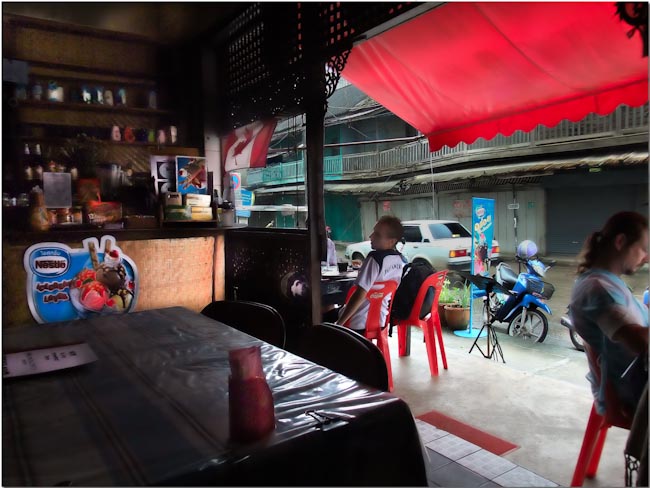
Looking out from Dave's watching the rain fall (captured with a point and shoot)
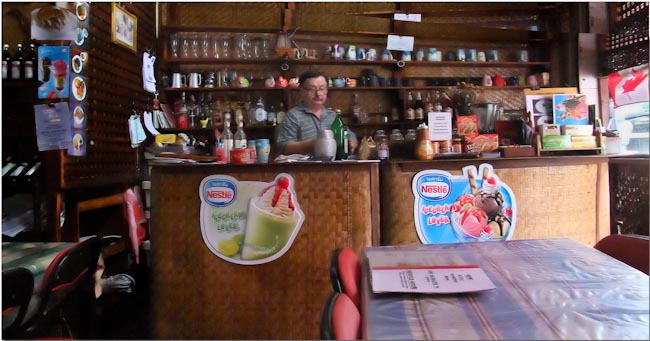
Dave hard at work (captured with a point and shoot)
A rainy street in Mae Sot, Canadian Dave's on the right
There is an unusually nice park dedicated to King Naresuan. The park is cared for very well and is popular with the locals. The location, weather, and sun tempted me to stop and make some captures which by themselves make for pretty pictures if nothing else.

Very small elephant statues line these steps
Very small elephant statues line these steps

Front entrance to the park
to the

The official park name
The official park nam

Stepping back and using a wider lens allows a different view of the same area
Stepping back and using a wider lens allows a differ of the same area

The rain lets up, the sun peeks through the clouds, and a nice image is the result
The rain lets up, the sun peeks t

The park includes a nice man-made lake area
The park includes a nice man-made lake area
Thailand Burma Friendship Bridge

Under the Friendship Bridge
Under the Friendship Bridge
The bridge physically is nothing to look at, but it does connect Thailand with Myanmar and the small town of Myawaddy. It is possible to make a visa run from this bridge and in fact I watched my 16 year old son as he strolled across the bridge into Myanmar, made an about face, and came back across with 15 more days annotated in his passport. The fees I remember as being very reasonable, something like 400-500 baht total. On my next visit I'll personally make a trip across to check out Myawaddy and the visa information.
Myawaddy is a very small and contained town/shopping area that doesn't allow for overnight visits. It's basically a trading center between the two countries with shops set up for tourists. There were very few western tourists, but there seemed to be a fair number of Asian tourists from China, Korea, Japan, and Malaysia among others.
While the bridge is nothing more than a few hundred meters in length that straddles a 40-50 meter wide river, with cracks appearing in the structure making it unsafe for heavy loads, the real action takes place under the bridge. You can see people swimming on the Burma side of the river and the Thai military guards keeping watch. Under the bridge, more on the Thai than the Burma side, is a small improvised hut that appears to serve a small family of several men and a teenage boy and girl. These same people where here during several visits weeks apart. Next visit I plan on getting their story. Why they choose to live in this dangerous and less than desirable location must be a fascinating story.

This Karen family lives here under the bridge
Karen family lives here under the brid
Under the bridge on the Thai side you'll find a number of military men armed with M16's. Usually they can be see chatting up the girls but when I aimed my camera at them they seemed quite interested to chat with me! Soldiers everywhere are always curious about soldiers from other countries and soon we had a good conversation going and I was able to learn much about their duties. The duty at this particular location was considered far superior to duty along other parts of the river. This area is considered a "safe zone", there are no safe zones for Thai soldiers anywhere else along this border and the Moei River.

Thai soldiers take a break
Thai soldiers take a break

Thai soldiers chatting up girls
hai soldiers chatting up girls
The Moei River runs along the Thailand/Burma border and this location is the most western point in Thailand. It seems like a popular place for locals to eat their lunch and for young couples to catch a nice view.

Thai soldiers chatting up girls
Mwestermost point in ailand along te Moei
The immigration station is at the head of the bridge and as you exit there is a high chain link and barbed wire fence to keep the controlled zone separate. Many trucks and other vehicles enter and exit Thailand at this point. Once past the immigration checkpoint there are vans and motorsais and other vehicles offering you a ride to the other side. My son walked this length in less than two minutes.

Thai immigration station as it faces Myanmar
Thai immigration station as it faces Myanmar

The rear of the Thai immigration station as you come back from Myanmar
The rear of the Thai immigration stationyou come back from Myanmar

City name
This gives you a brief look at Mae Sot, however Mae Sot's main feature is that its simply the gateway to the refugee camps and orphanages that plague the Thailand/Burma border. Mae Sot is the support town, the jumping off point, and the last well known Thai city before heading up/down the river to the camps. It's not surprising that the town is heavily populated by those of Karen descent, but perhaps it's surprising that the closer you look.. the more you'll find evidence of this being the most dense Christian area in all of Thailand, save for the camps themselves.
Disclaimer: This series is the most "dumbed down" I've ever done. The Thai government, and rightfully so, is very sensitive about this area and what is written about it. I can't write about what I've really seen and experienced without risking offending my Thai hosts. I encourage you to Google some of the information I've provided and read what's really happening in this area as written by those living in other countries without risk.
Charging your Devices While Traveling
Are you a frequent traveler who travels with your cell phone, PDA, GPS, portable hard drives, Bluetooth headset, booklite, and other electronic devices which requires half your suitcase be filled with chargers?
You get to your hotel room and need to charge your phone and you spend 10 minutes plugging in different chargers until you find the one that fits and makes all the blinky blink lights work?
I had enough of that noise years ago! Folks, there’s a much better solution.
Devices:
ALL of my devices save for my laptop and professional DSLR camera bodies now are powered and run from a USB port. I have all the devices listed above and more. I run and charge ALL of them through built in USB ports. How?
First, every time I replaced such a device I refused to replace it if it didn’t have a USB port. We normally replace these items every year or two, so it didn’t take long until every such device that I currently use had a USB port.
Small devices have “mini” USB ports. Your laptop has a full size USB port. The cables that come with such devices always have one size on each end. This makes things easy.
Second, I made adequately powered USB ports, and enough of them, on my next laptop a priority.
Let’s talk laptops:
Laptops generally come with USB 2.0 ports that put out significantly less power than a desktop's USB 2.0 ports. Many don’t realize this. Have you ever had an USB powered external hard drive where the cable came with two USB connectors to plug in? This is because USB powered external hard drives are almost always used with laptops. Laptops generally have limited powered USB 2.0 ports.
When shopping for a new laptop take note of the power output of the USB ports. This is a hard specification to find so you’ll have to search around a bit. It will help if you buy a name brand “business model” or a professional portable graphics workstation. These almost always come with full power USB ports.
Sure, you can power and charge 1-2 devices at a time with almost any laptop with a USB port. However, if you want to use your laptop, charge its battery at the fastest rate, power external hard drives, and charge your phone and other devices at the same time.. then you’ll need full power USB ports.
My business laptop is a 4.5 pound model with 4 full power USB 2.0 ports. It was offered with a choice of power adapters of different wattage levels. When used with the low power level adapter you could use the laptop and it would ‘slowly’ charge the battery. When used with the high power level adapter you can use and charge everything all at the same time. For an extra $10 on your initial order you can get the higher wattage level power adapter.
AC/DC/Air adapters. Look for this option when ordering your next laptop. All of mine have these for travel chargers. They’re smaller and lighter than the main charger and can be used virtually anywhere, in any type of transportation. You can use them on airplanes (these ports are usually available only on Business Class seats and above), in the car, or any hotel. I find them invaluable.

A Dell Brand AC/DC/AIR Converter
A Dell Brand AC/DC/AIR Converter
I carry a small zippered nylon bag with my laptop power adapter, 3 into 2 plug adapter, a short extension cord (many Thai hotel rooms only have one outlet), an extra mini flash card reader, and 4-5 small USB cables to power my devices. The bag is only 2x4x6 inches. All my charges, all my cables, everything I need while on the road goes in this bag. This charges my cell phone, PDA, GPS, Bluetooth headset, and external hard drives. I’m probably forgetting something.
Alternatives:
There are several alternatives to a business level laptop IF you still make sure all your devices can be powered and charged via the USB port.
If you visit Pantip Plaza or any other electronics store you’ll find a small power adapter that plugs into any outlet, and has 2-4 USB ports as outputs. These are specifically
made to power USB devices. They don’t do anything else.

A 50 Baht AC to USB Power Converter from Pantip
A 50 Baht AC to USB Power Converter from Pan
If you already have a powered USB hub, one powered by its own adapter, it ‘might’ be putting out enough power to charge your devices. The nice thing about these two adapters is that they don’t require a laptop.

Several AC powered USB Hubs
Several AC powered USB Hubs
A final and third option is a USB charger powered through the cigarette lighter of your vehicle. These come with 1-6 USB ports for charging, and come with full size or mini USB ports. These are just becoming popular so look around until you find one you like.

Automobile Cigarette Lighter to USB Power Converter, 60 baht at Pantip
Automobile Cigarette Lighter to USB Power Converter, 60 baht at Pantip
What about my DSLR batteries?
In the last ten years I’ve NEVER carried a charger for my DSLR batteries when traveling! Modern professional level DSLRs have batteries that provide enough power for at least 1000 images, often twice this amount, and I carry up to four batteries. Four batteries still weighs less and takes up less room than the big honking charger that charges them. I’ve yet to take a vacation long enough to exhaust the batteries, and I’ve traveled for up to a month at a time.
If you have a consumer level DSLR with small batteries they’re normally only good for 300-400 images. And the chargers for these are relatively small. You’ll probably need to carry a charger for this type of camera.
Next time you buy a device consider making a USB powered/charged device a priority. Reduce the ‘stuff’ you need to carry. Also remember, while a normal charger for your device is very specific and you’ll have a hard time finding one if it breaks or is forgotten at home, that USB ports are everywhere! You can find a USB port virtually anywhere in the world and charge your device in just an hour or two. This can be a real lifesaver.
Photography News of Interest
Waterproof digital camera anyone? There’s now many choices on the market. Digital Photography Review pulls off another of their great “group tests” which helps you compare at a glance, all the features, prices, and actual performance characteristics. You can read the group test here.
This is for you lucky Fuji Finepix F200EXR owners. A firmware update is available that serves to improve the intelligent flash system and adds four more languages. You can get it here.
Waterproof digital camera anyone? There’s now many choices on the market. Digital Photography Review pulls off another of their great “group tests” which helps you compare at a glance, all the features, prices, and actual performance characteristics. You can read the group test here.
New Canon Hybrid IS world’s first Image Stabilizer to compensate for two types of camera shake. This is a new Image Stabilization (IS) system promising 5 stops of correction and "dramatic" improvements. Nikons newest system offers 4 stops. Canon fans everywhere are wondering what new Canon lens will be released with this new Hybrid IS system. My guess is an undated 24-70/2.8 and possibly a new 70-200/2.8 IS. We shall see. You can read about it here.
Readers Submissions
Hi Steve,
Attached are some images from a recent trip to Pranburi, a little resort town about 30 minutes below Hua Hin.
The last 2 shots are taken just outside my office in Nonthaburi.

View from the room

The hammock outside was really comfy!

Taken just outside the room, it really was a lovely resort.
t outside the roomt ry

The infinity pool, with a nice view of the Gulf of Thailand

Our open air shower provided a pretty view of some Frangipani flowers.

A nice cocktail at the poolside!

HDR image of another view directly from the room.

And another one, also HDR.
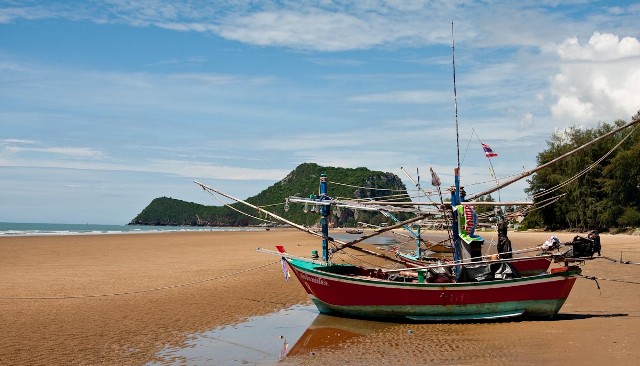
Low tide in the morning…
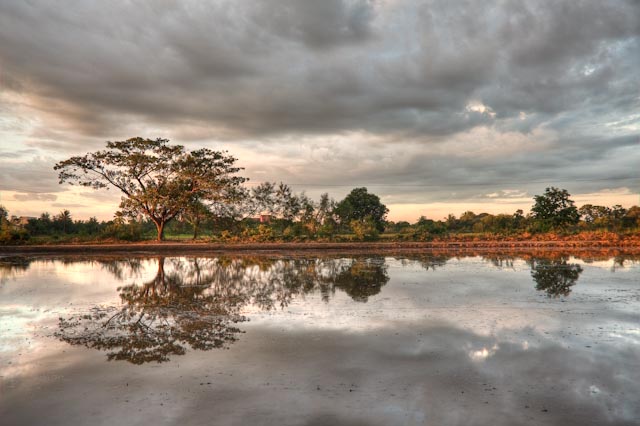
Not in Pranburi, but taken from the parking lot of my office in Nonthaburi. HDR.
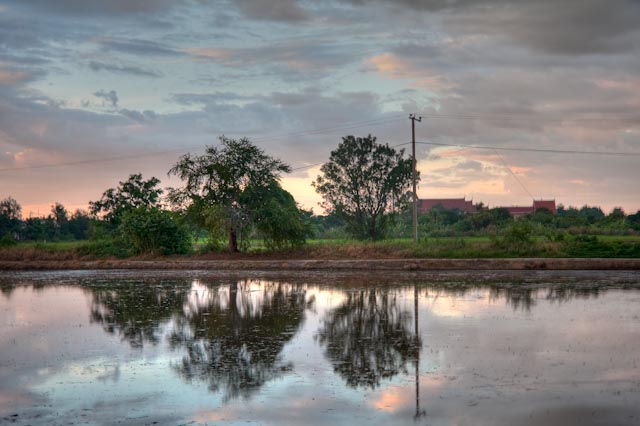
Another HDR from a view right outside my office building.
KVW
KVW –
Thanks for the images. Fun! What a huge difference I can see in your photography in just a few short months! You are making huge strides and great images! We always look forward to your images.
Thanks
Steve
Steve –
Thanks for looking at the photos…This is a new style adapted by my son and myself on a sony 828 …After painting watercolors all my life I was amazed to find out I could actually do the same thing with a digital camera..

The real good thing about the style is that you can paint 200 watercolors a day if the light is right….It is a simple point, make three or four adjustments, and shoot…
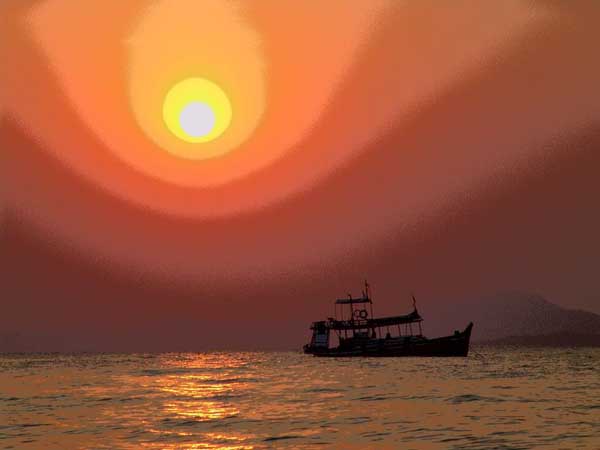
There is no other equipment involved i.e. a computer…You could probably do the same thing on a computer, but really I don't have time to mess around with it…I would rather be driving around on my motorbike looking for new subjects…
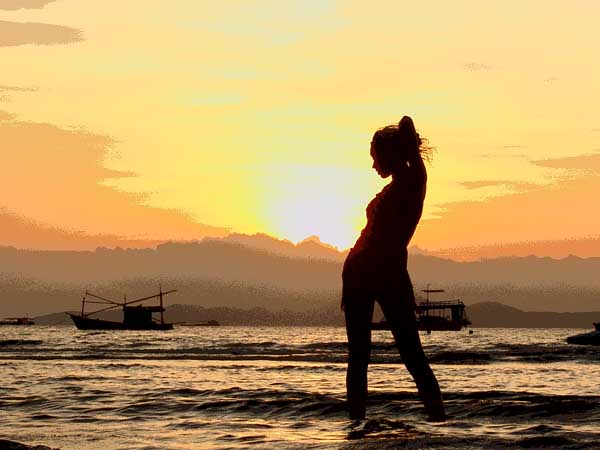
In fact, when I was in Sihanoukville, some guy from Italy showed me how to do it on his telephone, after I showed him what I was doing..
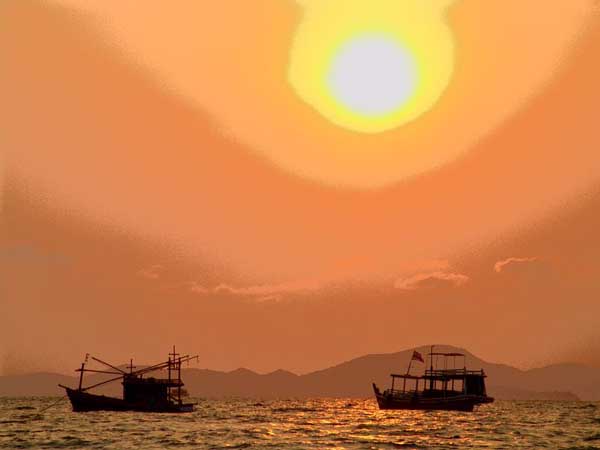
I travel to Pattaya every Nov. for a 6-7 month stay, so maybe those of you who are interested in looking at my style can get together….I can take photos that make my portrait subjects look like Picasso paintings….
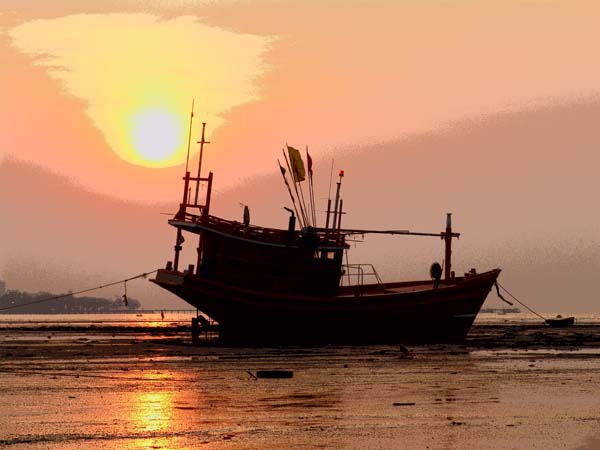
Thanks again, and PSS I have around 82,000 photos.
Larry
Larry –
I love your enthusiasm! Interesting photos too! I'm afraid you might rile old Pablo with your comparison and choke my inbox with 82,000 images, but we certainly want to see more of your work.. ;o) Keep them coming!
Steve
I suspect the readers submissions will be a highly anticipated section of this column and I encourage anyone with photographs and travel accounts they'd like to share to please send them to me at: QandA@Bkkimages.com
Readers Questions
Hey Stick
Do you ever give advice about cameras? I notice in your site that there a large number of shots taken in low lit areas.
I am building a website as a hobby of restaurants in Tokyo Bangkok Seoul etc www.chequebin.com (No where near ready for general viewing yet) and often have trouble getting a good shot in lowish lighting – for example in a place you know Bourbon St.
I have the Cyber shot Sony 7 MPX and have and rarely use a flash as I find it distorts colours and stuffs up the contrast.
I have and can use photo shop but the core shot has to have enough light and colour.
Anyhow I was wondering what camera you use and if you use a tripod for low lit shots?
Andy
Andy –
Stick forwarded your question to me.. it's a good question and will go well in the photo weekly on Stick's site.
First, there is no single answer. And there is no easy answer.
Every restaurant and lighting source will present a different set of variables. How these variables affect the picture will be to varying degrees, and your acceptance of the imperfections is dependent on how imperfect the images you're willing to
accept.
For instance, to start I'd recommend you read the first 5-8 weeklies about white balance, aperture, shutter speed, ISO, and the basics. You need a good working knowledge of these areas.
http://www.stickmanweekly.com/Photo/DigitalPhotographyIndex.html
Every one of these variables, ISO, aperture, focal length, focal distance, sensor size, white balance, ambient light, light sources you control, all of these variables come in to play and need to be properly and thoughtfully balanced to achieve anything
close to professional results, even or website images.
I can tell you what camera and lens Stick is using, both are fine pieces for low light, available light, use. The Canon 5d Mark II and the 35mm F1.4L lens. Using available low light you also pick up all the ambient light temperatures from stage and prop
lights. For your purposes you'll want to control the light and to control the light you'll need to add external lighting.. And when you do this, then the 35mm F1.4L lens probably would no longer be your best choice.
Are you talking plates of food, or a bar area or a seating area? More of an entire floor area? You see, more variables.. that much be reconciled with the variables I listed above.
In short, for low light work you need to know photography. You need to know gear. You need to be able to walk into a venue, evaluate, and know for certain which gear will work the best and provide the results you want.
Basically this is a job for professionals.. more so than many other types of photography.
HOWEVER.. if you were willing to learn to use a flash properly.. then you could get away with a much less expensive camera and lens. With a flash, "low light" is no more. Instead of a $2900 body and $1300 lens.. you could use a $700 body and
$300 lens and a $300 flash. Of course a $300 flash only gives you so many choices, so investing in say three wireless flashes that you could learn to set up properly.. would give you good results.
I haven't been able to give you a good definitive answer, much depends on how much you can budget for gear, and how much time you can budget to learn the gear.
What I can do is help you narrow things down a bit.
1. The camera Stick uses for his low light shots, lens included, cost about $4400 USD. This is just a single lens. Without a flash he's shooting at High ISOs which means his shots won't have maximum detail and the lighting will never be suitable
for your uses. Without a flash, you'll be picking up all the ambient light temperatures in the restaurant.. and there are usually at least 4-5.. Balancing these for the right look, if it can be done in a specific circumstance, takes skill.
Years of skill.
2. If you use a proper flash, you can shoot at ISO 100, get great detail, sharp images, acceptable colors, and so on.
3. How well you light your scene/subject, depends heavily on how many lights you have, how you use them, and your ability to control the lights.
Your current camera. Do yourself a favor and don't take any "experience" from it away with you.. except that you get what you pay for. It's probably a decent camera on the beach or outdoors in natural light.. but there is stops. Don't
think because the flash sucked on this camera, then flashes suck.
Something else you could do, is call me and schedule a workshop designed specifically around your needs. If you understood the basics (ISO, shutter speed, aperture, focal length, focal distance, etc, etc), and I mean really understood them.. then we could
learn to use off-camera portable strobes in a single day workshop. If you come in with no skills and we need to start from scratch, 3-4 days. This is very individual.
I hope this helps, and of course I was assuming that you wanted images of the quality which would enhance your website..
Let me know if you have more questions. Always happy to help.
Steve
you everea
Steve
Thanks for your comprehensive reply yesterday. I was unaware that Stickman's site had your photography weekly section. I am now, and have read the first 7 or 8, as suggested. I have been in Tokyo for a few years.
Mostly I try to take two pictures, one of the restaurant inside, and another of the food. Here is an example of the kind of shots I have taken: http://www.chequebin.com/restaurants1 They are in Tokyo. Many I am happy with but others are disappointing and there were another set of shots I wanted to take but did not because I knew they would fail, mainly due to lighting.
Today, I went in and priced some cameras today and Canon EOS 50 D: Body 41.000 BT, with 18-55 lens it is 45,000 BT. with the 18 – 200 lens is 61,000 Bt, The Mark 2 body is 99,000 Bt.
Would the EOS 50D be satisfactory? And if so what would be the best lens?…..I read that any zoom sacrifices clarity compared to a fixed lens. If anything a wide angle is more useful than a zoom…..This is especially true in Tokyo.
Andy
Hi Andy –
I'm glad you found my column. You're not the only one who hasn't noticed it yet.. need to find a way to make it stand out more.
About your questions.
1. Remember, the APS-C sized sensor cameras (crop frame, 40d,50d, Nikon D300, etc) have a smaller sensor which affects to areas.
a. Low light sensitivity. Takes more light than a full frame camera (Canon 5d Mark II, Nikon D700, etc) for a given noise/detail level in the image. This is very important if you want to use the camera without the benefit of a good off-camera light system.
b. This size sensor multiplies the focal length of the lens by 1.6x for Canon, 1.5x for Nikon. So a 20mm lens really has the field of view of a 26mm lens. This is important if you need the wider angle.
Both of these area seem to be important to your area of photography. There are ways to use a Canon 50d effectively for your uses, and it is a very good camera.
1. Use a crop wide angle zoom lens. The 10-22mm comes to mind.
2. Use the above lens with a very well thought out off-camera lighting system. This was the relative small maximum aperture of this type of lens isn't such a factor, you can shoot the camera at lower ISO's where the noise isn't so bad,
and the lighting makes for a nicer image regardless.
And no.. a zoom lens is not 'necessarily' less sharp than a prime. This used to be the case in the past, but most professional series zoom lenses are better than consumer primes (fixed focal distance), and just slightly less
than professional series primes. The differences are likely not that noticeable for your uses.
What matters is to pick the right lens for your purpose, being mindful of that particular lenses characteristics.
You need to choose one of two styles.
1. Available lighting.
2. External lighting.
For available lighting the 5d Mark II and either the 24mm F1.4L or the 35mm F1.4L would be the way to go.
For external lighting.. many models and lenses would work, like the 50D and the 10-22 wide angle zoom.. but not the external lighting becomes very important.
Steve
I am
Please submit your questions to QandA@Bkkimages.com All questions will be answered and most will show up in the weekly column.
A Snapshot of Bangkok Images Week in Review
Bangkok Images continues to grow and improve. I'm settling back down into my normal routine now that my son is back in Hawaii and effecting many changes which hopefully will help our customer base grow and our images improve.
1. We talked last week about how you can look forward to some professional reviews of relevant software packages. We have several in the works and many in the queue. I'm very happy our readership has grown to the point of making us desirable reviewers for the major software developers. Next week look for a review on a great new and free product that resizes your images for emailing or web posting purposes with the ease of a mouse click! We'll test it out and tell you how well it works, how the resulting image quality compares to its competition, and how we think it might be improved.
2. We ordered in the parts and built a new state of the art Intel imaging workstation! Its taken me a few weeks to tweak everything and achieve a stable and meaningful over clock and rebuild the system hard drive. This is a quality build that is both extremely quiet and even more powerful. In the coming weeks I'll share with you what components we used for the build and why, where we got them here locally in Thailand, and provide enough information so you can build the same workstation.
3. Bangkok Images offices have been going under a major renovation. Yes, I'm making the "offices" sound like a big deal when they're really just an office, printer room, and big learning/work table located in my home. New air conditioners, walls, ceilings, image friendly lighting, bathrooms, kitchen, paint, most everything is being renovated and will be new. They've been working for ten days now and driving me crazy and they're not expected to finish for another two weeks. I'll be hiding under a paint tarp during the day while the work, and trying to clear enough rubble away from my workstation to get this column out after they leave at night.
Exciting times for Bangkok Images! house and office renovation taking place it doesn't surprise me that some major cleaning and organizing is taking plac
Infocus Blog
Unwanted Toys
With a whole house and office renovation taking place it doesn't surprise me that some major cleaning and organizing is taking place. I've been in the office and printer room, under the equipment cabinets, looked on the shelves near the work table, and taken note of all the electronic toys and goodies no longer used for one reason or the other.
No less than three computers, a large server class UPS, an even bigger color laser, scads and scads of equipment manuals and their accompanying CD's and DVD's, two inkjet printers, four phones, a few stacks of 500gig hard drives, and a Creative Logic Flight stick. This is far from a complete list.
There's no telling how many of us have unused and unwanted electronic toys taking up storage space in closets, drawers, under tables, or just sitting there in the open. Most of this stuff still works but has been replaced. For instance, my Konica-Minolta Color Laser is a great machine and works fine. However, it runs on 110v and we have 220v in Thailand. I used a transformer for years with success, but finally replaced it with a new AIO (all in one) unit that runs on the local juice, does more things, and does everything over the local network. I no longer need a high volume high quality color laser that isn't network compatible.
Two inkjets have been replaced for the same reasons, and they still work too. No less than 12 500gig SATA II hard drives work, yet have been replaced. A laptop (earmarked for a good cause), 2 point and shoot cameras (also earmarked), one complete workstation, and one CPU/RAM/MB combo that is still current and tons of them are being sold today.
I don't want to throw this stuff away, and I don't want to go through the trouble of selling it. So, what to do with it? I've found good and deserving homes for a lot of this stuff. I've also put the word out to friends and family to please give me their old and not-working laptops and digital cameras. By mixing parts and pieces I can get a lot of these working. Sometimes I need an actual part so I venture down to Chinatown and can usually find very cheap used parts and when I must new parts.
In the last two years I've placed four laptops and three digital cameras to homes that could not otherwise afford them.
How do you place them? I'm sure you could give them away standing on the street corner though personally, I tend to place mine with individuals or families I meet during my travels.
Unfortunately not many of these people need server class UPS's or big color laser printers. 🙂 I'll figure something out. If anyone knows a good and worthy home for these big items please email me.
Further, if you have an old digital camera or ancient laptop and would like to give them to a good and worthy cause, please email me and I'll take them off your hands. For example a reader recently had one of the rare and coveted Fuji Finepix F31 point and shoot. It was in great condition, had a case, extra battery, very nice. But nothing would appear on the rear LCD. A trip to Chinatown and 250 baht later a brand new LCD screen was mounted and the camera was 100%. It's now in a good home in Isaan and making people happy.
Take a look through your old and unwanted toys. Know that many electronic items cannot be placed in the regular garbage and must be taken to a recycling center. If you run across something that might be useful to someone else please consider parting with it. Thank you.
Until next time..



